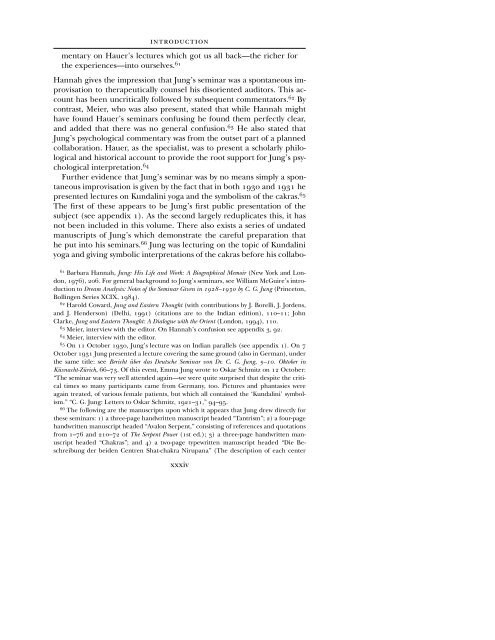CG JUNG - Countryside Anarchist
CG JUNG - Countryside Anarchist
CG JUNG - Countryside Anarchist
You also want an ePaper? Increase the reach of your titles
YUMPU automatically turns print PDFs into web optimized ePapers that Google loves.
INTRODUCTION<br />
mentary on Hauer’s lectures which got us all back—the richer for<br />
the experiences—into ourselves. 61<br />
Hannah gives the impression that Jung’s seminar was a spontaneous improvisation<br />
to therapeutically counsel his disoriented auditors. This account<br />
has been uncritically followed by subsequent commentators. 62 By<br />
contrast, Meier, who was also present, stated that while Hannah might<br />
have found Hauer’s seminars confusing he found them perfectly clear,<br />
and added that there was no general confusion. 63 He also stated that<br />
Jung’s psychological commentary was from the outset part of a planned<br />
collaboration. Hauer, as the specialist, was to present a scholarly philological<br />
and historical account to provide the root support for Jung’s psychological<br />
interpretation. 64<br />
Further evidence that Jung’s seminar was by no means simply a spontaneous<br />
improvisation is given by the fact that in both 1930 and 1931 he<br />
presented lectures on Kundalini yoga and the symbolism of the cakras. 65<br />
The first of these appears to be Jung’s first public presentation of the<br />
subject (see appendix 1). As the second largely reduplicates this, it has<br />
not been included in this volume. There also exists a series of undated<br />
manuscripts of Jung’s which demonstrate the careful preparation that<br />
he put into his seminars. 66 Jung was lecturing on the topic of Kundalini<br />
yoga and giving symbolic interpretations of the cakras before his collabo-<br />
61 Barbara Hannah, Jung: His Life and Work: A Biographical Memoir (New York and London,<br />
1976), 206. For general background to Jung’s seminars, see William McGuire’s introduction<br />
to Dream Analysis: Notes of the Seminar Given in 1928–1930 by C. G. Jung (Princeton,<br />
Bollingen Series XCIX, 1984).<br />
62 Harold Coward, Jung and Eastern Thought (with contributions by J. Borelli, J. Jordens,<br />
and J. Henderson) (Delhi, 1991) (citations are to the Indian edition), 110–11; John<br />
Clarke, Jung and Eastern Thought: A Dialogue with the Orient (London, 1994), 110.<br />
63 Meier, interview with the editor. On Hannah’s confusion see appendix 3, 92.<br />
64 Meier, interview with the editor.<br />
65 On 11 October 1930, Jung’s lecture was on Indian parallels (see appendix 1). On 7<br />
October 1931 Jung presented a lecture covering the same ground (also in German), under<br />
the same title: see Bericht über das Deutsche Seminar von Dr. C. G. Jung, 5–10. Oktober in<br />
Küsnacht-Zürich, 66–73. Of this event, Emma Jung wrote to Oskar Schmitz on 12 October:<br />
“The seminar was very well attended again—we were quite surprised that despite the critical<br />
times so many participants came from Germany, too. Pictures and phantasies were<br />
again treated, of various female patients, but which all contained the ‘Kundalini’ symbolism.”<br />
“C. G. Jung: Letters to Oskar Schmitz, 1921–31,” 94–95.<br />
66 The following are the manuscripts upon which it appears that Jung drew directly for<br />
these seminars: 1) a three-page handwritten manuscript headed “Tantrism”; 2) a four-page<br />
handwritten manuscript headed “Avalon Serpent,” consisting of references and quotations<br />
from 1–76 and 210–72 of The Serpent Power (1st ed.); 3) a three-page handwritten manuscript<br />
headed “Chakras”; and 4) a two-page typewritten manuscript headed “Die Beschreibung<br />
der beiden Centren Shat-chakra Nirupana” (The description of each center<br />
xxxiv


